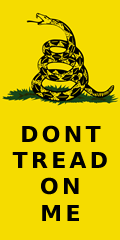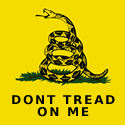During the U.S. Revolutionary War, Colonel Christopher Gadsden designed and presented a flag to the new Navy Commander-in-Chief, Commodore Esek Hopkins, for him to use as his personal standard. This flag, which was soon thereafter presented to the South Carolina state legislature, has since become known as the ‘Gadsden Flag‘ and was among the distinctive early symbols of the independent United States.
The flag was described as follows in the journals of the South Carolina legislature:
Col. Gadsden presented to the Congress an elegant standard, such as is to be used by the commander in chief of the American navy; being a yellow field, with a lively representation of a rattle-snake in the middle, in the attitude of going to strike, and these words underneath, “Don’t Tread on Me!”
Symbolism and Background
The symbolism of the Gadsden Flag is likely lost on many modern Americans, who are a much more docile lot than our revolutionary forefathers. The establishment of the Eastern Diamondback Rattlesnake as an American revolutionary mascot began as early as 1751 when Benjamin Franklin suggested, in response to England’s sending convicted criminals to America, that we begin sending rattlesnakes to England. Franklin continued to use snakes as a symbol for the colonies, including the famous ‘Join, or Die‘ cartoon in which he advocated colonial unity.
Franklin wrote an essay for the Pennsylvania Journal in which he explained why the rattlesnake would be a fitting symbol for the American people and the American spirit:
I recollected that her eye excelled in brightness, that of any other animal, and that she has no eye-lids. She may therefore be esteemed an emblem of vigilance. She never begins an attack, nor, when once engaged, ever surrenders: She is therefore an emblem of magnanimity and true courage. As if anxious to prevent all pretensions of quarreling with her, the weapons with which nature has furnished her, she conceals in the roof of her mouth, so that, to those who are unacquainted with her, she appears to be a most defenseless animal; and even when those weapons are shewn and extended for her defense, they appear weak and contemptible; but their wounds however small, are decisive and fatal: Conscious of this, she never wounds till she has generously given notice, even to her enemy, and cautioned him against the danger of treading on her. Was I wrong, Sir, in thinking this a strong picture of the temper and conduct of America?
Individual Liberty
The Gadsden Flag remains a fitting symbol for freedom-loving Americans, as does its defiant slogan, “don’t tread on me.” These hark back to the revolutionary Americans who demanded liberty and were willing to take up arms to gain and defend it. It harks back to a kind of fervent individualism and self-sufficiency that we seem to have lost. Americans in revolutionary times were glad to be rid of England’s heavy-handed sovereignty over their affairs, but they were unwilling to replace heavy-handed England with a new heavy-handed America. The U.S. Constitution and the government it created were intended to start from a baseline that gave all power to the people, taking for the state only that which was absolutely necessary to protect individual liberty.
The very wording of the Gadsden Flag slogan, “don’t tread on me,” is focused on individual liberty—not collective stability or national authority. It doesn’t say, “don’t tread on the Federal Government.” It doesn’t even say, “don’t tread on us.” It is a flag that represents the position of the individual, not of the state, government, or community. America was built on trusting individuals to handle their own affairs, and leaving them to succeed or fail on their own merits.
More importantly, the flag represents a warning to aggressors and tyrants who would trample upon our liberties. We were a tenacious people; we were armed and capable of defending ourselves. But we were willing to ‘live and let live.’ It was only when attacked—when tread upon—that the snake would strike.
Sic Semper Tyrannis
The official motto of the Commonwealth of Virginia is ‘sic semper tyrannis‘—a Latin phrase usually translated as ‘thus always to tyrants’ or ‘death to tyrants.’ Like the Gadsden Flag, this motto demonstrates a willingness on the part of the American people to defend themselves against tyrants—even those in their own government. To ensure they could do so long into the future, the founders enshrined the right to keep and bear arms into the Constitution. They realized more than anybody that even a republican government like England’s could become tyrannical. Arms were—and still are—as essential deterrent to government seizing too much power from the people.
Most Americans, however, have lost this perspective. Too many of us trust the government to protect our liberties, and so we allow our government to grow larger and more powerful. Too many of us accept limitations on our freedoms because the limitations don’t immediately effect us, or because it seems good in the moment to outlaw ‘hate speech’ and ‘dangerous’ weapons. Too many of us naively believe that our ideas will never be the ideas that government chooses to suppress. Too many of us believe that the local police or our military will always be there to protect us, and will always be on our side. Too many of us believe we will never need to act individually—violently, if necessary—to protect ourselves, our families, our liberty, our communities, or our country.
But some of us are concerned about the erosion of liberty in America. Some of us see that outlawing ‘hate speech’ is only one step away from outlawing unpopular speech. Some of us see that outlawing ‘assault weapons’ is only one step away from a broad disarmament of the American people. Some of us recognize that if the Ku Klux Klan can’t march on city hall, it’s only a matter of time before Christians, gays, soldiers, or atheists can’t either because their potentially controversial speech might offend somebody. And if people can’t march on city hall anymore, it’s only a matter of time before they can’t meet in private either. If we continue allowing ourselves to be muzzled and disarmed, the American people will no longer be free.
Do You Agree?
If you like what you’ve read here, the absolute best thing you can do is vote for political candidates at the local, state, and national level who espouse these same ideals (if you can find them). The next best thing is to join and support organizations that work to protect and defend the core civil liberties enjoyed by Americans: free speech, free press, free assembly, freedom of religion, and the right to keep and bear arms.
Finally, if you want to make a small statement of your beliefs, please put one of the following web banners on your web site or on your social networking pages. I would appreciate if you linked the banner to this page, but you don’t have to. They are free for the taking (see below for detailed licensing information).





Licensing
‘Don’t Tread On Me’ is licensed under a Creative Commons Attribution-Noncommercial-NoDerivatives 4.0 International License.
Gadsden Flag graphics, including all ‘Don’t Tread On Me’ web buttons and banners, are partially based on the February 21, 2009, version of Wikipedia’s Gadsden Flag graphic. These buttons are licensed under a Creative Commons Attribution-Share Alike 3.0 United States License.



